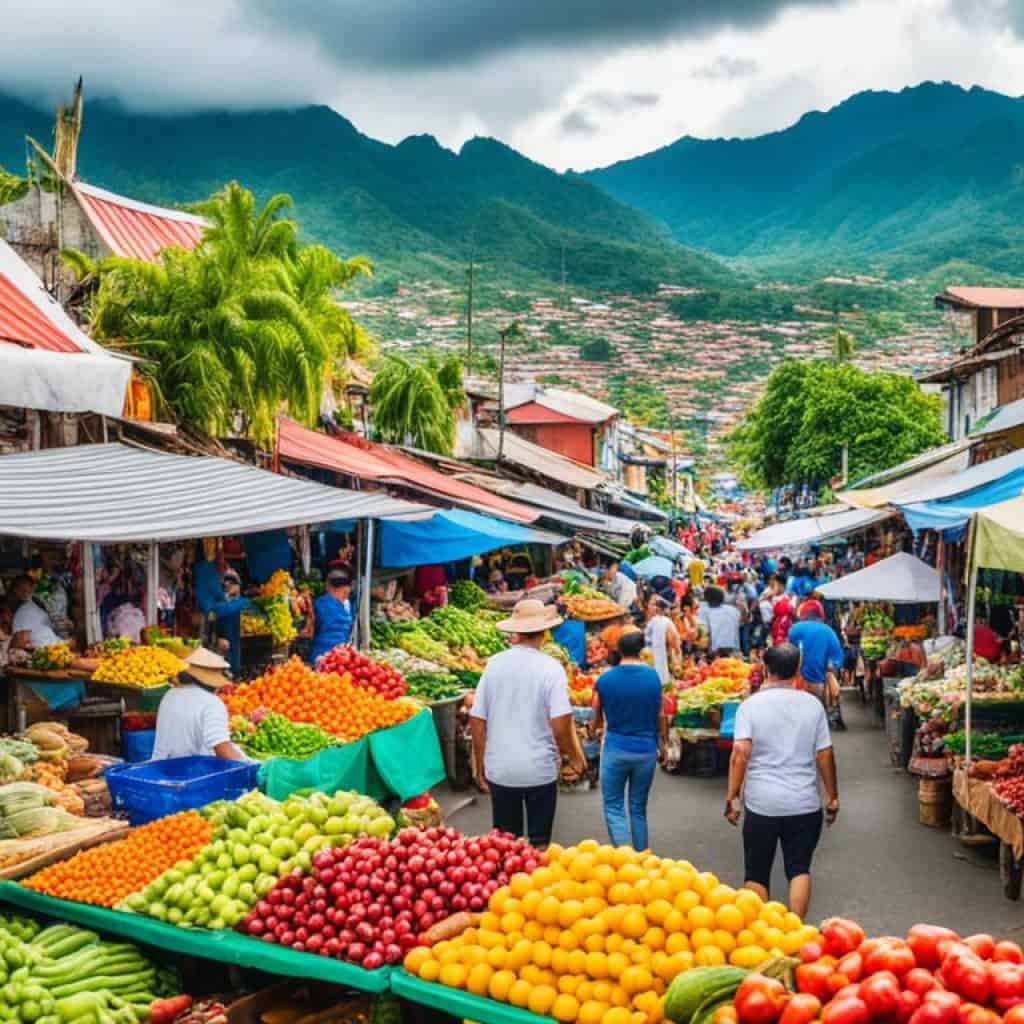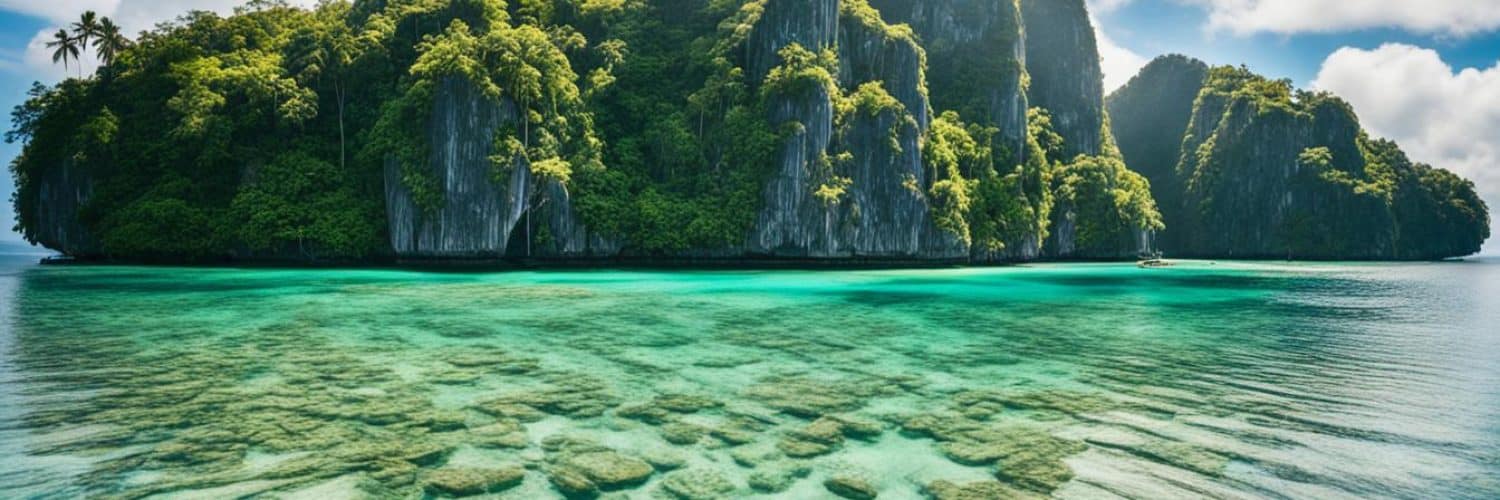Are you considering a move to the Philippines? It’s a country that offers a treasure trove of natural beauty, from its stunning beaches to its vibrant culture. But is it the best place for you to live?
Before you start packing your bags, it’s important to weigh the pros and cons of moving to the Philippines. From the cost of living to the healthcare system, there are several factors to consider. So, should you take the leap and relocate to this tropical paradise?
In this article, we’ll explore all the aspects of moving to the Philippines, providing you with the information you need to make an informed decision. From the Filipino climate and lifestyle to safety and security, we’ll delve into the key factors that will impact your experience as an expat in this vibrant country.
Key Takeaways:
- The Philippines offers a unique blend of natural beauty, vibrant culture, and affordable living.
- The cost of living is relatively low compared to many other countries.
- Expats are advised to have private medical insurance due to the limitations of the public healthcare system.
- Filipino Time is a cultural aspect that may require adjustment for expats.
- English is widely spoken in the Philippines, but learning some Filipino phrases can enhance your interactions and understanding of the culture.
Reasons to Consider Moving to the Philippines
If you’re contemplating a move abroad, the Philippines has much to offer. From the benefits of living in a beautiful tropical paradise to the affordable cost of living, there are numerous reasons why expats choose to call the Philippines home. Here are some compelling reasons to consider making the move:
Affordable Cost of Living
The Philippines provides a cost-effective living compared to many other countries. From housing to food and transportation, you’ll find that your money stretches further in the Philippines. Whether you’re looking to rent an apartment or purchase a property, housing options are available to suit various budgets. Additionally, the cost of groceries, dining out, and public transportation is generally lower than in many Western countries, making the Philippines an attractive choice for expats seeking a more affordable lifestyle.
Warm and Welcoming Culture
The Filipino people are known for their warm and friendly nature, which makes settling into the local culture and lifestyle a breeze. You’ll be greeted with smiles and hospitality wherever you go, making you feel right at home in this beautiful country. The vibrant expat community further adds to the sense of belonging, providing opportunities to connect with like-minded individuals and forge new friendships.
Stunning Natural Beauty
The Philippines is renowned for its breathtaking natural beauty. From white sandy beaches and crystal-clear waters to lush mountains and vibrant rice terraces, the country offers a paradise-like setting that’s perfect for relaxation and exploration. Imagine waking up to picturesque views and having world-class diving spots just a short distance away. The Philippines truly is a haven for nature lovers.
“I fell in love with the Philippines’ beauty, but it’s the warmth of the people that made me want to stay. The cost of living is a bonus!” – Emma, British Expat
Whether you’re looking to embrace a more laid-back lifestyle, experience a different culture, or enjoy an affordable retirement, the Philippines offers a wealth of benefits. From the cost-effective living to the welcoming culture to the stunning natural landscapes, living as an expat in the Philippines can be a truly enriching experience.
The Filipino Climate and Weather
The Philippines is known for its tropical weather, characterized by hot and humid conditions throughout the year. Whether you are visiting or planning to move to the Philippines, it’s important to familiarize yourself with the climate to better prepare for your stay.
The average temperature in the Philippines ranges from 25.5°C (77.9°F) in January to 28.3°C (82.9°F) in May. The warm temperatures create a perfect environment for enjoying the country’s stunning beaches and outdoor activities.
However, it’s worth noting that the humidity level remains high consistently, fluctuating between 71% and 85%. This year-round humidity can be overwhelming for some individuals, especially those who are not accustomed to such conditions.
To give you a better idea, here is a table summarizing the average temperature and humidity levels in the Philippines:
| Month | Average Temperature (°C) | Average Humidity (%) |
|---|---|---|
| January | 25.5 | 85 |
| February | 25.7 | 82 |
| March | 26.5 | 80 |
| April | 27.1 | 79 |
| May | 28.3 | 77 |
“The tropical weather in the Philippines offers warm temperatures and high humidity year-round, creating a vibrant and lively atmosphere for both locals and visitors.”
It’s advisable to dress comfortably in lightweight and breathable fabrics to cope with the humidity. Additionally, staying hydrated and taking breaks in shaded areas can help you stay cool and comfortable during your time spent outdoors.
Discovering the Natural Wonders
The tropical climate of the Philippines contributes to its lush and diverse natural beauty. From picturesque beaches to breathtaking landscapes, there is an abundance of natural wonders waiting to be explored. Whether it’s swimming in crystal-clear waters or trekking through scenic mountains, the Philippines offers a paradise for nature enthusiasts.
Exploring the vibrant marine life in world-renowned dive spots, such as Tubbataha Reefs Natural Park or Apo Island, is a must-do when in the Philippines. The warm waters and abundant marine biodiversity make it a dream destination for snorkelers and scuba divers.
In addition to aquatic adventures, the tropical weather also allows for lush rainforests to thrive, offering opportunities for hiking, birdwatching, and discovering unique flora and fauna. Places like the Banaue Rice Terraces and Mount Pinatubo present awe-inspiring landscapes that showcase the country’s natural wonders.
Immersing yourself in the beauty of the Philippines’ tropical environment can be a transformative experience, allowing you to connect with nature and appreciate the wonders of our planet.
Healthcare System in the Philippines
The healthcare system in the Philippines faces challenges in terms of resources and funding, ranking 124th out of 195 countries. This affects the accessibility and quality of healthcare services provided by public institutions.
For expats considering a move to the Philippines, it is advisable to have private medical insurance that can ensure access to quality healthcare. Approximately 30% of the population in the Philippines relies on private insurance for medical coverage.
“Having private medical insurance is essential for expats to confidently navigate the healthcare system in the Philippines and receive the necessary medical care when needed.”
Key Points:
- The public healthcare system in the Philippines faces limitations in terms of resources and funding.
- Expats are advised to have private medical insurance for access to quality healthcare.
- Approximately 30% of the population in the Philippines relies on private insurance for medical coverage.

Having private medical insurance in the Philippines ensures that you have peace of mind and the necessary medical cover for any healthcare needs. It offers a safety net to access quality healthcare services outside the public system. Make sure to research and choose a reputable insurance provider that caters to expatriates living in the Philippines.
Filipino Time and Punctuality
Filipinos have a relaxed approach to timeliness, known as “Filipino Time.” It is common for people to arrive late to events or appointments. This cultural aspect originated from Spanish colonists and has become deeply ingrained in Filipino society.
Languages in the Philippines
The Filipino Language
Filipino, also known as Tagalog, is the national language of the Philippines and serves as the basis for the Filipino language. It is the first language of a significant portion of the population and is predominantly spoken in the capital city, Manila, and surrounding regions. Learning some Filipino words and phrases can greatly enhance cultural understanding and daily interactions with locals.
“Ang hindi marunong magmahal sa sariling wika, daig pa ang hayop at malansang isda.”
Bilingualism in the Philippines
English proficiency in the Philippines is high, with English being the medium of instruction in schools and universities. This bilingual environment makes it easier for expats to adapt to their new surroundings and interact with the local community.
“Language is the road map of a culture. It tells you where its people come from and where they are going.”
Language Resources in the Philippines
Food and Cuisine in the Philippines
Filipino cuisine is a vibrant and delicious fusion of flavors, reflecting the country’s rich cultural heritage and diverse culinary traditions. From traditional dishes passed down through generations to modern culinary creations, Filipino food offers a tantalizing experience for food enthusiasts. Local specialties in the Philippines showcase the unique flavors and ingredients that make the cuisine stand out.
One iconic Filipino dish is adobo, which consists of marinated meat (often pork or chicken) cooked in vinegar, soy sauce, garlic, and spices. The combination of tangy and savory flavors creates a mouthwatering taste that Filipinos love. Another popular dish is kare-kare, a stew made with oxtail, tripe, and vegetables, simmered in a rich peanut sauce. The creamy texture and complex flavors of kare-kare make it a must-try dish.
No discussion of Filipino cuisine is complete without mentioning lechon, a whole roasted pig that is often the centerpiece of celebrations. The crispy skin and tender meat make lechon a favorite among locals and tourists alike. It symbolizes the Filipino hospitality and the joy of coming together to celebrate special occasions.
For those seeking vegetarian options, Filipino cuisine also offers a variety of dishes made with fresh local produce. From flavorful vegetable stews like sinigang (sour soup) to hearty bean and vegetable dishes like pinakbet, there are plenty of vegetarian choices to satisfy every palate.
Exploring the local markets, also known as palengkes, is a delightful experience for food enthusiasts. These bustling markets offer a wide array of fresh fruits, vegetables, seafood, and spices. You can immerse yourself in the sights, aromas, and flavors of Filipino ingredients, discovering new flavors and ingredients that inspire your culinary adventures.
Overall, Filipino food is a celebration of fresh ingredients, bold flavors, and shared meals. It captures the essence of Filipino culture and history, reflecting the warmth and hospitality that define the Filipino people.
| Popular Filipino Dishes | Description |
|---|---|
| Adobo | A savory dish made with marinated and braised meat (pork or chicken), simmered in vinegar, soy sauce, garlic, and spices. |
| Kare-kare | A flavorful stew made with oxtail, tripe, and vegetables, served in a rich peanut sauce. |
| Lechon | A whole roasted pig with crispy skin and tender meat, often the star of festive occasions. |
| Sinigang | A sour soup made with tamarind or other souring agents, loaded with vegetables and your choice of meat or seafood. |
| Pinakbet | A vegetable dish made with a mix of local greens, squash, eggplant, and bitter melon, sautéed with shrimp paste. |
Cost of Living in the Philippines
One of the major advantages of living in the Philippines is its relatively low cost of living. Expats will find that their expenses are significantly lower compared to many other countries, allowing them to enjoy a comfortable lifestyle without breaking the bank.
When it comes to everyday expenses, such as rent, transportation, and dining out, the Philippines offers affordable options. Whether you choose to live in the bustling capital city of Manila or the serene beaches of Cebu, there are housing options available to suit different budgets. From apartments to houses and condos, you’ll find a wide range of choices to fit your preferences and financial situation.
Transportation in the Philippines is also affordable, with options like jeepneys, tricycles, and buses providing convenient and cost-effective ways to navigate within and between cities. Additionally, the country’s vibrant street food scene offers delicious and inexpensive dining options, allowing you to savor local flavors without straining your budget.
However, it’s important to note that the prices for imported goods and luxury items may be higher in the Philippines. If you have specific preferences or require imported products, it’s advisable to factor in those additional costs into your budget.
Cost of Living Comparison:

As seen in the table above, the cost of living in the Philippines is significantly lower compared to the United States and the United Kingdom. This makes it an attractive destination for expats seeking affordable living without compromising on quality of life.
By taking advantage of the affordable cost of living, expats in the Philippines can enjoy a comfortable lifestyle while saving money for their future or exploring the country’s many attractions.
Religious and Cultural Landscape in the Philippines
The Philippines is a country deeply rooted in religious traditions, with Catholicism being the predominant faith. Approximately 92% of the population identifies as Christian, and Catholicism plays a central role in shaping Filipino culture and traditions. The influence of Catholicism can be seen in various aspects of daily life, from religious festivals and processions to the strong sense of community and devotion.
However, the religious landscape of the Philippines is also characterized by religious diversity, reflecting the country’s rich history and cultural influences. Other religions practiced in the Philippines include Islam, Protestantism, and various indigenous belief systems. This religious diversity adds to the vibrant tapestry of Filipino culture, fostering tolerance and understanding among different religious communities.
“The Philippines is a testament to the beauty of religious and cultural diversity. The coexistence of different faiths and religious practices contributes to the rich tapestry of Filipino identity.”
Major Religions in the Philippines:
- Catholicism: As mentioned earlier, Catholicism is the dominant religion in the Philippines, with a significant majority of the population professing the faith.
- Islam: Islam is the second-largest religion in the country, particularly concentrated in the southern regions of Mindanao and the Sulu Archipelago. Muslim Filipinos have their own distinct cultural practices and traditions.
- Protestantism: Various Protestant denominations have gained followers in the Philippines, including Evangelical, Baptist, and Methodist churches.
- Indigenous Beliefs: Many indigenous communities in the Philippines continue to practice their traditional animistic beliefs, which are often intertwined with Catholicism or other organized religions.
The coexistence of multiple religions in the Philippines is a testament to the country’s religious tolerance and acceptance. It is not uncommon to witness interfaith celebrations and events that foster unity and strengthen the bonds among religious communities.
Cultural Traditions and Festivals:
The interplay between religion and culture is evident in the numerous festivals and cultural traditions celebrated throughout the country. These events often showcase a blend of indigenous practices and Catholic traditions, creating a unique and vibrant cultural experience.
One such example is the Sinulog Festival in Cebu City, which commemorates the Filipino people’s conversion to Christianity. The festival features street dancing, parades, and religious processions, with participants donning colorful costumes and performing choreographed routines.
Another notable cultural event is the Feast of the Black Nazarene in Manila, where devotees gather to honor the image of the Black Nazarene, a significant religious icon believed to possess miraculous powers. Thousands of devotees participate in the procession, often enduring the crowd and intense physical exertion as an act of piety.
| Festival Name | Location | Significance |
|---|---|---|
| Sinulog Festival | Cebu City | Celebrates the Filipino people’s conversion to Christianity |
| Feast of the Black Nazarene | Manila | Honors the image of the Black Nazarene, a significant religious icon |
| Pahiyas Festival | Lucban, Quezon | Thanksgiving for a bountiful harvest and showcases colorful rice decorations |
The Pahiyas Festival in Lucban, Quezon is yet another example, featuring houses adorned with colorful rice decorations known as “kakanin.” The festival is a celebration of gratitude for a bountiful harvest and pays homage to the agricultural traditions of the region.
The religious and cultural diversity found in the Philippines creates a fascinating and inclusive atmosphere that welcomes and appreciates various beliefs and practices. It is this diversity that contributes to the uniqueness and beauty of the Filipino identity.
Historical Background of the Philippines
The Philippines has a rich and complex history that has shaped its identity as a nation. Understanding the historical background of the Philippines provides insights into the struggles for independence and the impacts of World War II.
The journey to independence began with Spanish colonization in the 16th century. For more than three centuries, the Philippines was under Spanish rule, which significantly influenced its culture, language, and religion. The Spanish conquest was met with resistance from Filipino revolutionaries, who fought for their rights and freedom.
The turning point in the Philippines’ history came with the Philippine-American War in 1899, as the United States took over from Spain. This period marked the shift from one colonizer to another and ignited the Filipino struggle for self-rule and independence. The resistance against American rule grew stronger, culminating in the declaration of the Philippines’ independence on July 4, 1946.
“Freedom is always the most valuable possession that man can possess. Down the ages, down the corridors of history, the Filipino has fought and sacrificed for his freedom. Independence has long been the dream of his people. With the enduring spirit of independence, the Filipino has dared all for love of country.”
– Carlos P. Romulo
During World War II, the Philippines was a major battleground between the Allies and the Axis powers. The country suffered devastating consequences, including the destruction of cities, loss of lives, and widespread displacement. However, the resilience and bravery of the Filipino people became a symbol of courage and hope.
| Key Events | Date |
|---|---|
| Spanish colonization begins | 1521 |
| Philippine Revolution against Spanish rule | 1896 |
| Philippine-American War | 1899-1902 |
| Declaration of Philippine independence from the United States | 1946 |
| Japanese occupation during World War II | 1942-1945 |
The historical background of the Philippines serves as a reminder of the nation’s resilience, strength, and aspiration for self-determination. It is a story of the Filipino people’s unwavering spirit and their pursuit of a brighter future.
Filipino Perception of the United States
Despite some political differences, Filipinos generally have a positive perception of the United States. A majority of the population holds a favorable view of the US, making it an appealing destination for American expats.
“The United States has always been seen as a symbol of progress and opportunity in the eyes of Filipinos. It represents economic prosperity, technological advancements, and a strong ally in times of need.”
– Maria Santos, Manila Times
Historical ties between the Philippines and the US play a significant role in shaping this perception. The Philippines was a colony of the United States for nearly 50 years, from 1898 to 1946, and this period of American influence left a lasting impact on the culture, education, and governance of the archipelago.
The Impact of US-Filipino Relations
The close relationship between the United States and the Philippines extends beyond historical partnership. The two nations continue to maintain strong ties in various aspects such as trade, defense, and diplomacy.
US businesses have heavily invested in the Philippines, contributing to economic growth and job opportunities for Filipinos. American companies operating in the country have played a vital role in driving innovation and technological advancements across industries.
Military cooperation is another significant aspect of the US-Filipino relationship. The Philippines is a key regional ally for the United States in Southeast Asia, with joint military exercises and intelligence sharing contributing to regional security and stability.
Filipino Expat Community in the United States
The positive perception of the United States is also influenced by the experiences of the Filipino diaspora. Over four million Filipinos live in the United States, making it one of the largest immigrant communities in the country.
| Benefits of US-Filipino Relations | Outlook for the Future |
|---|---|
|
|
Overall, the Filipino perception of the United States remains positive due to shared historical ties, strong bilateral relations, and the experiences of the Filipino diaspora. The United States continues to be viewed as a land of opportunities and a valued partner in various aspects of growth and development.
Rodrigo Duterte and Philippine Politics
The presidency of President Rodrigo Duterte has seen occasional expressions of a desire for more independence from the United States. However, the Philippines maintains a complex relationship with its long-time ally, strategically balancing its interests between the United States and other nations.
In terms of Philippine politics, President Duterte’s administration has exhibited a more assertive stance towards the United States. This includes pursuing closer ties with regional powers like China and Russia, as well as diversifying the country’s foreign policy engagements.
The Philippines’ relationship with the United States dates back to its colonial history, shaping the country’s political landscape and influencing its governance. Despite occasional disagreements, the alliance between the Philippines and the United States remains strong, with both countries recognizing the mutual benefits of their strategic partnership.
Philippines-US Relations: Key Points
- The Philippines and the United States have a long history of diplomatic, economic, and military cooperation.
- The Mutual Defense Treaty, signed in 1951, serves as the cornerstone of the security alliance between the two countries.
- Economic relations include trade partnerships and initiatives promoting investments and business collaborations.
- Educational and cultural exchanges strengthen people-to-people ties and enhance mutual understanding.
Despite occasional geopolitical shifts, the United States remains an important economic and security partner for the Philippines. Cooperation in areas such as counterterrorism, disaster response, and regional stability continues to define the bilateral relationship.
President Duterte's Approach
President Duterte has emphasized the need to pursue an independent foreign policy for the Philippines, aiming to protect national sovereignty and secure the country’s economic interests. This approach includes engaging with a diverse range of countries to strengthen regional partnerships and maximize opportunities for growth and development.
President Duterte’s administration has shown a willingness to explore new avenues of cooperation while maintaining traditional alliances. By pursuing an active role in regional affairs, the Philippines seeks to address shared challenges, promote economic integration, and safeguard its national interests.
Philippine Politics and the Role of President Duterte
President Duterte’s leadership style reflects the complexities and dynamic nature of Philippine politics. His pragmatic approach and decisive decision-making have appealed to many Filipinos who seek stability, security, and socio-economic progress.
While his policies have attracted both support and criticism, President Duterte’s bold initiatives, such as the “War on Drugs” and socioeconomic reforms, have reshaped the political landscape and brought attention to pressing issues faced by the country.
In conclusion, President Rodrigo Duterte’s administration has demonstrated a desire for more independence from the United States, reflecting a shifting geopolitical landscape. The Philippines, however, maintains a complex relationship with the US, recognizing the strategic importance of their alliance while pursuing broader opportunities for growth and development.
Safety and Security in the Philippines
Safety is of utmost importance when considering a move to the Philippines. While the country offers numerous attractions and opportunities, it is essential to be aware of the crime rates, particularly in certain areas like Manila. Expats are advised to take necessary precautions and remain vigilant to ensure their personal safety.
“The best way to stay safe in the Philippines is to always be aware of your surroundings and avoid crowded places, especially at night. It’s also recommended to keep valuable belongings out of sight, securely lock doors and windows, and refrain from displaying signs of affluence.”
Although the Philippines is generally a safe country, it is important to exercise caution and be proactive in maintaining personal safety. By staying informed, adhering to local guidelines, and being mindful of one’s surroundings, expats can mitigate potential risks and enjoy their time in this beautiful archipelagic nation.
Crime Rates in the Philippines
Crime rates vary across different regions of the Philippines, and it is crucial to be aware of the local situation in order to make informed decisions. According to the Philippine National Police (PNP), crime index rates have shown a general downward trend in recent years, reflecting efforts to improve safety and security nationwide.
| Year | Crime Volume | Crime Rate |
|---|---|---|
| 2018 | 579,289 | 498.7 |
| 2019 | 504,296 | 419.1 |
| 2020 | 452,810 | 359.08 |
Note: Crime volume is measured per 100,000 population.
While these figures indicate a decrease in overall crime rates, it is still important to exercise caution and practice safety measures. Researching crime statistics and consulting with local authorities or expat communities can provide valuable insight into specific locations and help ensure a safe and secure experience in the Philippines.
Cost of Living and Accommodation in the Philippines
The cost of living in the Philippines is generally lower compared to many Western countries. This makes it an attractive destination for those seeking an affordable lifestyle without compromising on quality. From everyday expenses to housing options, the Philippines offers a range of choices to suit different budgets and preferences.
Housing Options in the Philippines
When it comes to accommodation, the Philippines provides a variety of options. Whether you prefer the convenience of city living or the tranquility of suburban areas, there are apartments, houses, townhouses, and condos available for rent or purchase.
City apartments are a popular choice for expats who want to be in the heart of the action, with easy access to amenities, restaurants, and entertainment. These apartments come in various sizes and styles, catering to different budgets.
For those who prefer more space or want to experience a traditional Filipino lifestyle, houses and townhouses are excellent choices. They often offer more room for families or individuals who value privacy and a backyard for leisure activities.
If you desire a balance between convenience and luxury, condos provide an attractive option. These modern residential units often come with amenities such as swimming pools, fitness centers, and 24-hour security.
Rent Prices in the Philippines
Outside of the capital city, rental rates tend to be lower, making it even more affordable for expats to find suitable housing options. In provinces and suburban areas, a one-bedroom apartment can be rented for as low as $150 to $300 per month.
Electricity Costs in the Philippines
While rent prices in the Philippines are generally affordable, it’s essential to consider other living expenses, such as electricity. The cost of electricity can vary depending on the location, type of accommodation, and usage.
Electricity rates in the Philippines are charged per kilowatt-hour (kWh). The average residential rate is around $0.13 to $0.20 per kWh. It’s important to note that electricity usage can increase during the hot summer months when air conditioning units are in high demand.
To manage electricity costs, it is advisable to be mindful of energy consumption by using energy-efficient appliances, unplugging unused devices, and utilizing natural ventilation when possible.
Summary
Living in the Philippines offers the opportunity to experience a more cost-effective lifestyle. With a variety of housing options and affordable rent prices, individuals can find suitable accommodations that meet their needs and budgets. While electricity costs can be a factor to consider, it is manageable with conscious energy use. By understanding the cost of living and accommodation options in the Philippines, prospective expats can make informed decisions when planning their move to this diverse and vibrant country.

Education System in the Philippines
The education system in the Philippines is a dynamic mix of American and Spanish influences, offering diverse options for both public and private schools. Whether you are a local or an expat, you’ll find a range of educational institutions catering to different needs and preferences.
Government-funded public schools play a vital role in providing free education to Filipino students. These schools follow the K-12 system, which includes six years of primary education, four years of junior high school, and two years of senior high school. The K-12 system aims to equip students with the necessary skills and knowledge for higher education or the workforce.
For expat families or those seeking alternative educational approaches, international schools in the Philippines are excellent options. These schools offer various curricula, including American, British, International Baccalaureate (IB), and more. The presence of international schools reflects the diverse expat community and ensures that children can continue their education seamlessly.
quote: “Education is the passport to the future, for tomorrow belongs to those who prepare for it today.” – Malcolm X
Attending international schools in the Philippines provides students with a global perspective and a multicultural learning environment. These schools often have well-equipped facilities, qualified teachers, and extracurricular activities that enhance students’ overall development.
Comparison of Public and International Schools
| Aspects | Public Schools | International Schools |
|---|---|---|
| Curriculum | Follow the K-12 system mandated by the Department of Education | Offer various curricula (American, British, IB, etc.) |
| Language of Instruction | Primarily Filipino and English | English, with some schools offering bilingual programs |
| Class Size | Can be large, averaging around 30 to 40 students | Usually smaller class sizes, providing more individual attention |
| Teaching Staff | Teachers may have varying qualifications and experience levels | Qualified international educators with relevant teaching experience |
| Extracurricular Activities | Offer limited extracurricular options | Provide a wide range of extracurricular activities and clubs |
While public schools provide free education, international schools generally require tuition fees. The cost of international school education varies depending on the institution, curriculum, and facilities provided. It’s important to research and consider the financial implications before enrolling your child in an international school.
Regardless of the type of school you choose, the education system in the Philippines aims to develop students’ critical thinking, creativity, and holistic growth. It’s essential to assess your child’s educational needs and goals while considering factors such as location, curriculum, and affordability. Visiting schools, meeting teachers, and talking to other parents can help you make an informed decision.
Investing in your child’s education is a significant step towards their future success, and the Philippines offers diverse educational opportunities that can shape their academic journey.
Conclusion
Moving to the Philippines offers a unique blend of natural beauty, vibrant culture, and affordable living. Whether you’re looking for pristine beaches, breathtaking landscapes, or a rich cultural experience, the Philippines has it all. With a lower cost of living compared to many other countries, you can enjoy a comfortable lifestyle without breaking the bank.
Before making the decision to move, it’s important to consider factors such as healthcare, safety, and personal preferences. While the healthcare system in the Philippines may have limitations, having private medical insurance can provide you with access to quality healthcare services.
As with any new destination, it’s crucial to stay vigilant and take necessary precautions for your safety. While certain areas may have high crime rates, being aware of your surroundings and avoiding crowded places can significantly reduce risks. Assessing your comfort level and readiness for a relaxed approach to timeliness, known as “Filipino Time,” is also important.
Living in the Philippines offers an opportunity to immerse yourself in a diverse culture and build lasting connections with both the Filipino community and the vibrant expat community. Exploring the perks and challenges, in addition to considering your own preferences and priorities, will help you determine if living abroad in the Philippines is the right choice for you. Are you ready to embark on this exciting adventure?
FAQ
Should I move to the Philippines?
Moving to the Philippines offers a unique blend of natural beauty, vibrant culture, and affordable living. However, it’s important to consider factors such as healthcare, safety, and personal preferences before making a decision. Exploring the perks and challenges of living in the Philippines can help determine if it is the right destination for your next adventure.
What are the benefits of living in the Philippines?
The Philippines offers a cost-effective living compared to many other countries, with affordable housing, food, and transportation. The warm and friendly nature of the Filipino people and the vibrant expat community make it easy to settle into the local culture and lifestyle.
What is the cost of living in the Philippines?
The cost of living in the Philippines is relatively low compared to many other countries. Rent, transportation, and dining out are affordable, making it an attractive option for expats. However, prices for imported goods and luxury items may be higher.
How is the healthcare system in the Philippines?
The Philippines’ public healthcare system is ranked 124th out of 195 countries, with limited resources and funding. Expats are advised to have private medical insurance to ensure access to quality healthcare services. Approximately 30% of the population in the Philippines relies on private insurance for medical coverage.
Is punctuality important in the Philippines?
Filipinos have a relaxed approach to timeliness, known as “Filipino Time.” It is common for people to arrive late to events or appointments. This cultural aspect originated from Spanish colonists and has become deeply ingrained in Filipino society.
What is Filipino cuisine like?
Filipino cuisine is known for its flavorful and fresh dishes. Popular dishes include adobo, kare-kare, and lechon. Local markets offer a variety of food options, including vegetarian choices. Exploring the diverse culinary scene in the Philippines is a delightful experience for food enthusiasts.
What is the historical background of the Philippines?
The Philippines gained independence from American rule in 1946, following years of Spanish colonization and the Philippine-American War. The country’s history is intertwined with the struggles for independence and the impacts of World War II. Understanding the historical context provides insights into the Filipino identity.
How safe is it to live in the Philippines?
Safety can be a concern in the Philippines, with high crime rates reported in certain areas, particularly in Manila. Expats are advised to remain vigilant, avoid crowded places, and take necessary precautions to ensure their personal safety.
What is the cost of living and accommodation like in the Philippines?
The cost of living in the Philippines is generally lower compared to many Western countries. Accommodation options include apartments, houses, townhouses, and condos. Rent prices are more affordable, but electricity can be expensive, especially during the hot summer months.
What is the education system like in the Philippines?
The education system in the Philippines is a mix of American and Spanish influences, offering both public and private schools. Government-funded public schools provide free education, while international schools cater to expat families with various curricula options.


















Add comment